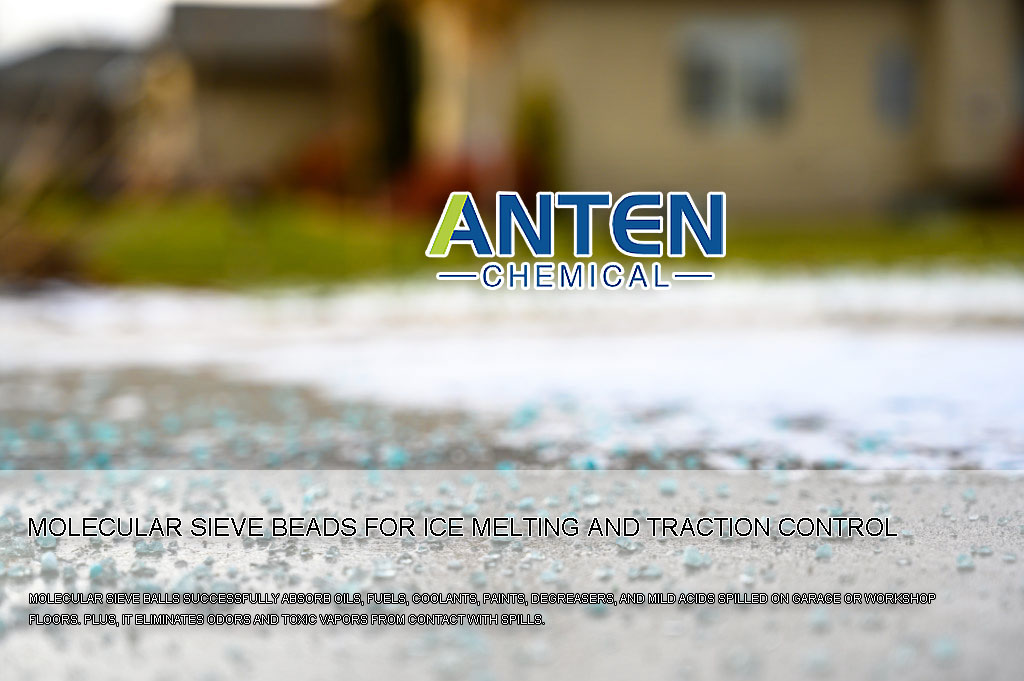
Molecular sieve beads for ice melting and traction control
Molecular sieve beads successfully absorb oils, fuels, coolants, paints, degreasers, and mild acids spilled on garage or workshop floors. Plus, it eliminates odors and toxic vapors from contact with spills.
Studies have shown that molecular sieve beads do not disintegrate when saturated with liquid. Hence, the product does not create a smooth surface on the floor. Instead, it soaks up excess fluid and creates traction control while handling spills.
In many cases, synthetic molecular sieve beads are light green to beige in color and are easily seen on floors. This provides efficiency when cleaning spills as the location of the product application can be easily determined.
Because molecular sieve balls absorb and absorb liquids and heavy metals, the application prevents caustic chemicals from penetrating into cracks in floors and surfaces. This prevents structural or material damage that can occur when concrete, stone, and brick are exposed to hazardous chemicals.
When the temperature reaches 32 degrees Fahrenheit or 0 degrees Celsius, the water freezes and turns to ice. There are a plethora of products on the market that provide traction control on driveways, stairs, and walkways. However, these products often contain high concentrations of corrosive chemicals and salts, both of which can have a significant impact on the environment and can cause damage to concrete or vehicles.
Synthetic molecular sieve beads for ice melting and traction control
Synthetic molecular sieve balls provide excellent traction control and ice management due to their water absorption and cation exchange capabilities. Molecular sieve balls can absorb up to 50 percent of their weight in water, a property that allows them to remove the water layer from the surface of the ice. When water is absorbed, the molecular sieve balls embed themselves in the snow and ice, providing traction control.
At the same time, the molecular sieve balls adsorb sodium contained in products such as rock salt and prevent it from seeping into the soil when the ice melts. This protects lawns, plants, and trees from chemical burns. Materials such as concrete and brick are porous and absorb water as ice and snow melt. When water refreezes and expands in the pores, these materials are stressed and damaged in the form of cracks and pits. Repairs are often expensive and require the replacement of structures such as driveways or stairs.
The synthetic molecular sieve balls absorb water and embed themselves in the ice through solar energy absorption.
It was proven to withstand freeze and thaw cycles indefinitely, and no degradation was observed during hydration and dehydration. This process allows for ice management and traction control while minimizing concerns about structural damage.
In high-traffic areas, it is important to use a product that provides consistent traction control. The synthetic molecular sieve balls immediately begin to absorb water and provide continuous traction control throughout the winter; as snow and ice melt and expose previous molecular sieve ball applications, the mineral will continue to provide traction control due to its durable construction.
Because the synthetic molecular sieve ball contains no toxic chemicals, it can be swept out on the lawn after the last thaw, or collected and reused the following winter.
Reference
- Zeolite molecular sieves can be used in oxygen production equipment
- New Tech – Zeolite Mask Making for N95 Standard
- Strong Zeolite Absorbent Improves LNG and LPG Production by CO2
- Antibacterial – Remarkable Functions of Zeolite in Personal Care Products
- 3a molecular sieve
- 4a molecular sieve
- 5a molecular sieve
- 13x molecular sieve
- natural zeolite is a natural mineral from the rock
- What Are Zeolites?
- Micro-Speaker Having an Air Adsorbent – molecular sieves
- Breakthrough Results in Molecular Sieves Research
- Hemostatic with Molecular Sieves are Used in First Aid Kit
- Molecular Sieves Beads – for ice Melting and Traction Control
- molecular sieve can reduce harmful gas emissions and recycle
- MSDS Material Safety Data Sheets
- Crystallization Mechanism of Molecular Sieves
